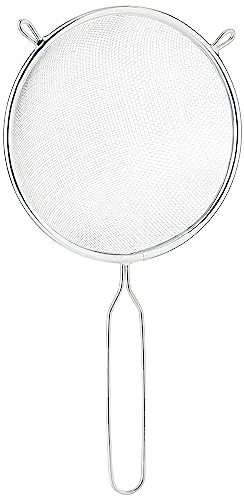Yes, a sieve is a common tool used for draining pasta
A sieve, also known as a colander or strainer, is a kitchen utensil that is typically used for draining liquid from solid substances, such as pasta, fruits, vegetables, and grains. It consists of a meshed or perforated bowl or container with a handle. When it comes to draining pasta, a sieve is an essential tool that helps separate the pasta from the cooking water, making it convenient to remove excess moisture before serving the pasta.
The advantages of using a sieve for draining pasta
Using a sieve for draining pasta offers several advantages. Firstly, a sieve allows for efficient and quick draining. The mesh or perforations in the sieve help strain out the pasta while retaining the cooking water, preventing the pasta from becoming soggy and overcooked due to excess moisture. Additionally, a sieve is easy to clean and store, making it a practical tool for any kitchen.
Alternatives to using a sieve for draining pasta
While a sieve is the most commonly used tool for draining pasta, there are alternatives that can serve the same purpose. One alternative is using a colander, which is a larger version of a sieve with larger holes or perforations. A colander allows for more substantial amounts of pasta to be drained at once, but it may not effectively strain out smaller pasta shapes like orzo or acini di pepe.
Another alternative is using a slotted spoon or tongs to retrieve the pasta from the cooking water. This method requires more time and effort, as the pasta needs to be scooped out in smaller batches, but it can be effective for smaller quantities or when a sieve or colander is not available.
Tips for using a sieve to drain pasta
When using a sieve to drain pasta, there are a few tips to keep in mind for optimal results. Firstly, ensure that the size of the mesh or perforations in the sieve is appropriate for the type of pasta being drained. Smaller pasta shapes may require a finer mesh to prevent them from slipping through the holes.
Secondly, it is important to shake the sieve gently to remove excess water from the pasta. Avoid pressing the pasta against the mesh or squeezing it, as this can lead to breakage or mushy texture. Allow the natural gravity and shaking to separate the pasta from the water.
Lastly, consider using a larger bowl or pot underneath the sieve to catch the drained pasta and prevent it from falling onto the countertop or stovetop. This can help with easy transfer of the pasta to a serving dish or mixing with sauce.
A sieve is indeed a useful tool for draining pasta. It offers efficient and quick draining, helps prevent the pasta from becoming soggy, and is easy to clean and store. However, if a sieve is not available, alternatives such as a colander or slotted spoon can also be used. Regardless of the tool used, it is important to handle the pasta with care to prevent breakage or mushy texture. With the right technique, draining pasta using a sieve can result in perfectly cooked and delicious noodles.






